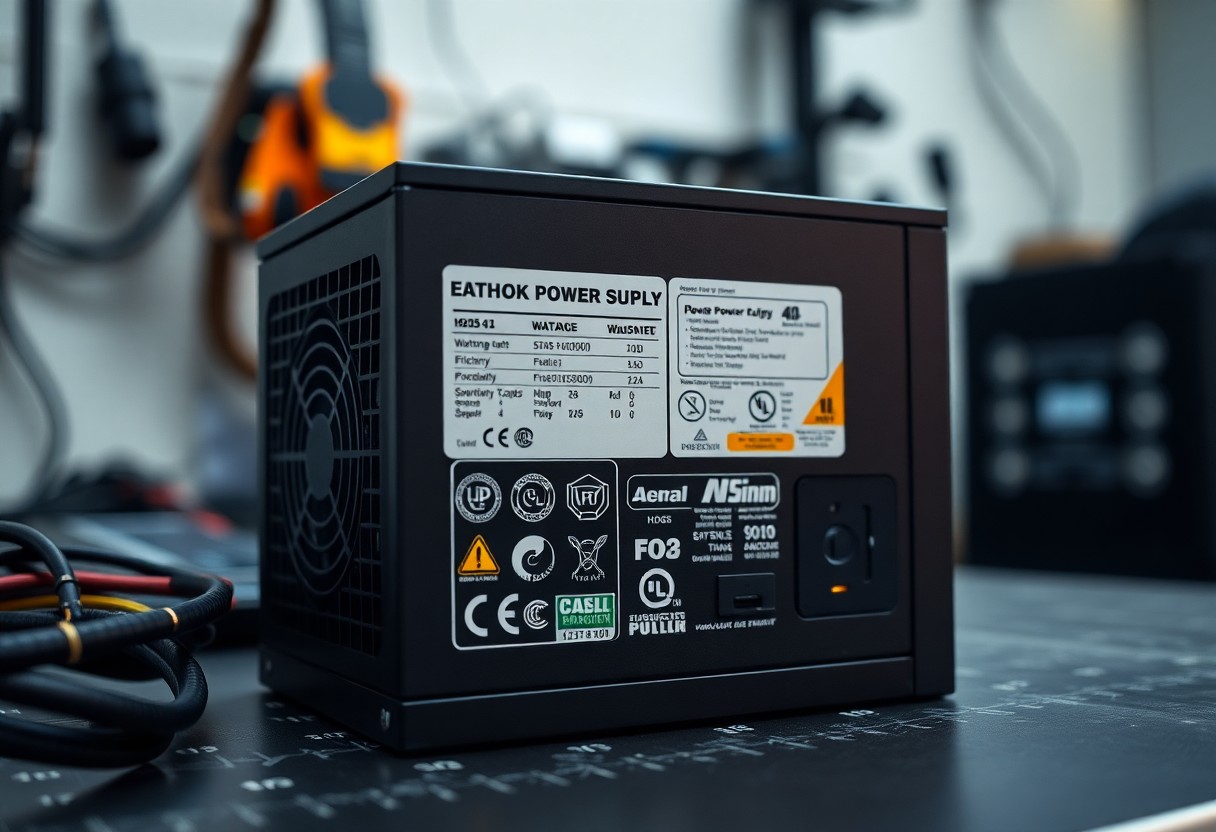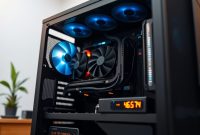Efficiency plays a vital role in ensuring your computer or electronic device runs smoothly and reliably. When opting for a power supply, you must consider not just the wattage needed for your components, but also the efficiency rating, which impacts your energy consumption and operating costs over time. Additionally, the brand of the power supply can influence reliability and performance. In this guide, you’ll learn how to make informed choices about wattage, efficiency, and trusted brands to power your setup effectively.
Understanding Power Supply Wattage
The wattage of a power supply is a fundamental aspect that determines its capacity to supply power to your components. Understanding wattage can help you make informed decisions when building or upgrading your system, ensuring you have enough power for optimal performance. Knowing the right wattage is vital to prevent instability or damage to your hardware.
What is Wattage?
Around the world of electronics, wattage refers to the amount of power consumed by a device over a period of time. In the context of power supplies, wattage indicates how much power your unit can deliver to your computer components, such as the CPU, GPU, and other peripherals. Higher wattage generally provides more headroom for powerful components.
How to Calculate Your Wattage Needs
Beside understanding wattage, calculating your specific wattage needs is vital for choosing a suitable power supply. You should consider the total power requirement of all the components in your system, including the CPU, GPU, storage drives, and cooling systems, and make sure to factor in any future upgrades.
Indeed, calculating your wattage needs starts by listing each component’s power consumption, often found in the product specifications. Using a reliable online power supply calculator can streamline this process, giving you an estimated wattage based on your selected hardware. It’s advisable to add a buffer of around 20% to your total wattage calculations, as this accounts for peak usage and ensures your power supply runs efficiently and safely.
Efficiency Ratings Explained
Some power supplies have efficiency ratings that indicate how effectively they convert AC power from the wall into usable DC power for your components. Higher efficiency means that less energy is wasted as heat, which can lead to reduced energy bills and cooler system temperatures. Understanding these ratings helps you make informed decisions for your build, ensuring that you invest in a power supply that meets your performance expectations while minimizing unnecessary energy loss.
The Importance of Efficiency in Power Supplies
Behind every component in your system lies an energy demand, and an efficient power supply is key to meeting that demand without excessive waste. An effective power supply helps you maximize the potential of your hardware while keeping operational costs low. By choosing a power supply with a high efficiency rating, you optimize your computer’s performance, longevity, and environmental impact.
Common Efficiency Ratings (80 Plus Standards)
By understanding common efficiency ratings, such as the 80 Plus standards, you can better assess the value of your power supply. These ratings indicate a power supply’s efficiency at various loads, ensuring you get a unit that aligns with your needs. Typically, silver, gold, platinum, and titanium ratings correspond to increasing levels of efficiency, helping you identify how much energy will be lost as heat.
Due to the growing demand for more energy-efficient components, power supplies labeled with the 80 Plus standards have become a benchmark in the industry. These grades represent a minimum efficiency of 80% at 20%, 50%, and 100% of rated load, with each subsequent tier (silver, gold, platinum, titanium) offering improved efficiency levels. This means that when you invest in a higher-rated power supply, you not only save on electricity costs but also improve your system’s thermal performance, leading to enhanced reliability and longevity for your components.
Top Power Supply Brands
If you’re on the hunt for a reliable power supply, identifying the top brands in the industry can significantly ease your decision-making process. Established names not only offer a variety of options in terms of wattage and efficiency but also come with a reputation that you can trust. From high-performance units to budget-friendly choices, the right brand can enhance the overall performance and longevity of your PC components.
Renowned Brands and Their Offerings
Power Supply brands like Corsair, EVGA, Seasonic, and Antec are renowned for their commitment to quality and performance. Each brand provides a range of models catering to various user needs, from entry-level power supplies to high-end options equipped with advanced features. Their focus on efficiency and innovative design ensures that you can find a power supply that meets your requirements without compromise.
Brand Reliability and Customer Reviews
Reviews of power supply brands are often a reliable indicator of their overall performance and user satisfaction. Many customers share their experiences regarding stability, noise levels, and efficiency, helping you gauge which brands live up to their promises. A collection of positive reviews will often highlight the brand’s consistency and after-sales support, crucial elements for making an informed choice.
In addition to user satisfaction, examining detailed reviews can offer insights into brand reliability over time. You’ll discover recurring themes in customer feedback, such as the durability of components and the effectiveness of warranty services. Brands with a solid track record often receive praise for their unwavering commitment to quality, making them a safe choice for your next power supply purchase.
Choosing the Right Power Supply for Your Needs
Many factors influence your choice of power supply, including wattage, efficiency, and specific use cases. Understanding your system’s power requirements is important in selecting a suitable power supply that ensures stable performance. Assessing the components in your build, such as CPU, GPU, and any additional peripherals, will help you determine the ideal wattage and features you require for optimal function and reliability.
Considerations for Gaming vs. Workstations
An understanding of the differences between gaming rigs and workstations is important when choosing a power supply. Gaming systems usually demand higher wattages to support powerful graphics cards and CPUs, while workstations may require more stable power for multi-threaded workloads. Evaluate your primary uses and tailor your power supply choice accordingly to meet your system’s unique demands.
Future-Proofing Your Power Supply
Against the backdrop of rapidly evolving technology, future-proofing your power supply is a wise decision. Opting for a power supply with slightly higher wattage than you currently need allows you to accommodate upgrades, such as enhanced GPUs or additional components, without immediately needing a replacement.
Indeed, future-proofing involves selecting a reliable power supply that not only meets today’s requirements but also anticipates future needs. Consider investing in a unit with modular cables for easier upgrades, and look for one that features a higher efficiency rating. This way, you can ensure that your system remains capable and efficient as you incorporate new technologies or expand your setup down the line. Additionally, brands known for longevity and performance will offer warranties that reflect confidence in their products, providing you assurance for years to come.
Installation and Maintenance Tips
Despite the importance of choosing the right power supply, proper installation and maintenance are key to ensuring optimal performance. Follow these tips to enhance your installation and longevity:
- Ensure compatibility with your hardware.
- Use appropriate screws and cables for secure connections.
- Keep the power supply clean and dust-free.
- Monitor temperatures to prevent overheating.
Any misstep during installation can lead to issues with your system’s functionality.
Installing Your Power Supply Correctly
Maintenance begins the moment you install your power supply. Always double-check that the connections are secure and that cables are routed neatly to ensure optimal airflow within your case. Avoid overloading the power supply by adhering to the manufacturer’s guidelines regarding wattage. This attention to detail enhances reliability and extends the lifespan of your components.
Maintaining Efficiency Over Time
About long-term performance, keeping your power supply running efficiently demands regular attention. Clean out dust build-up from vents and fan grilles to ensure proper airflow, as restricted airflow can hinder efficiency. Furthermore, periodically check connections and cables for wear, reducing energy losses due to resistance. This proactive approach helps maintain high efficiency.
Hence, maintaining efficiency over time is a continuing commitment that rewards you with stable performance and lower energy costs. Schedule routine inspections of your power supply, keeping in mind that environmental factors, such as humidity and temperature, can also impact performance. By establishing a maintenance routine, you can ensure that your power supply operates at peak levels for many years.

Frequently Asked Questions
All power supplies can seem daunting, but understanding the key factors, including wattage, efficiency, and brand, helps simplify your choices. This section will address your most pressing questions to ensure you make informed decisions when selecting a power supply for your setup.
Common Queries About Power Supplies
Among the common queries are concerns about how much wattage is sufficient for your system, the importance of efficiency ratings, and the reliability of various brands. Addressing these questions can empower you to choose a power supply that meets your unique needs without overspending.
Troubleshooting Power Supply Issues
Along the way, you might encounter power supply issues such as sudden shutdowns, system instability, or failure to start. Understanding these problems can help you pinpoint the source and determine if replacement or repair is necessary.
Hence, always check the connections and cables to ensure they are securely attached. You should also examine compatibility with your components and consider testing the PSU with a multimeter. If issues persist, isolating components and troubleshooting each part will help identify the defective component. This methodical approach ultimately saves time and resources in your quest for a stable power supply.
Final Words
Conclusively, choosing the right power supply involves careful consideration of wattage, efficiency ratings, and reputable brands. You should ensure that the wattage meets your system’s demands for optimal performance. Opt for a power supply with a high efficiency rating to save on energy costs and generate less heat. Additionally, selecting well-known brands can provide you with reliability and peace of mind regarding quality. By taking these factors into account, you can make an informed decision that suits your needs and enhances your overall computing experience.



